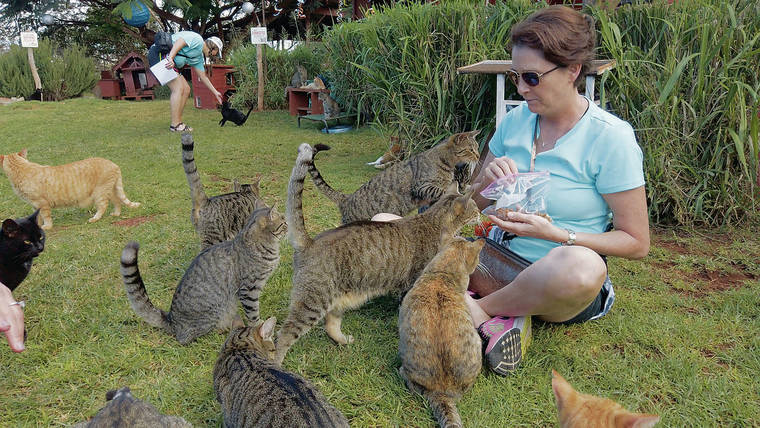Lanai Cat Sanctuary hopes to reopen soon since closing in March


COURTESY LANAI CAT SANCTUARY
A visitor feeds cats at the Lanai Cat Sanctuary. The sanctuary closed in mid-March because of the new coronavirus.


Cat lovers across the country can’t wait until a home for feral cats reopens on Lanai.
The Lanai Cat Sanctuary has been receiving calls, emails and social media messages asking when it will reopen, but that still has not been determined, said the sanctuary’s executive director, Keoni Vaughn.
The sanctuary, which now has about 670 cats, closed March 17, before the statewide coronavirus Opens in a new tab lockdown and order for out-of-state travelers to quarantine for two weeks.
“We did this (closing to visitors) in the best interest of the Lanai community,” Vaughn said, adding that the sanctuary will probably open after the state’s two-week quarantine for travelers is lifted.
Since the sanctuary normally receives about 15,000 visitors a year, with about 90% coming from outside of Hawaii, the sanctuary decided to close its doors to visitors to avoid attracting people who may be infected with the virus to the small island.
The sanctuary, which doesn’t charge admission, relies heavily on donations — 95% of which come from off-island — and has seen funding dry up since the closure, forcing it to dip into reserves to cover the $42,000 monthly operating costs, Vaughn said.
Don't miss out on what's happening!
Stay in touch with breaking news, as it happens, conveniently in your email inbox. It's FREE!
“We’re weathering the storm,” he said. “Hopefully, this will pass soon, and we can reopen to the public.”
The sanctuary has 10 staff members, comprised of full-timers, part-timers and those on call, which is the same number as before the outbreak. Vaughn said the sanctuary received a federal coronavirus loan to keep employees working.
The sanctuary, which began in 2009 when founder Kathy Carroll started sheltering cats at the location, does more than just provide a home for feral or unsocialized felines. The “fur seasons” also reduce the island’s feral cat population, which would otherwise feed on the eggs of native or endangered birds such as the Hawaiian petrel, wedge-tailed shearwater and aeo.
The shelter removes feral or unsocialized cats from protected wildlife areas and brings them to the 3.5-acre cat park, where they live in a fenced-in area with wooden structures and baskets where they can lounge and be stroked by human admirers. The sanctuary also brings in a veterinarian from Oahu to spay or neuter the cats. The property remains rustic, with no electricity and only running water, but has plenty of amenities for the boarders, including a “catfurteria.”
Vaughn said the sanctuary is a tourist attraction with part of its draw being the guest experience. When tourists come in, they are met by a greeting committee of dozens of cats gathering at the gate, seeking treats and petting sessions.
“These are all super- friendly cats,” he said. “It’s a quite peaceful, relaxing environment.”
The sanctuary has received national attention after appearing on CNN and CBS News, and even people who don’t love cats will go to see what the fuss is all about, Vaughn said.
During its closure the sanctuary has been using other ways to generate funds, such as virtual cat adoptions for $30 a month, which provide donors with pictures of a cat and updates.
The shelter is also offering Zoom cat adoptions and will ship the cat to its new owner. The shelter normally adopts out about 50 cats a year without adoption fees, with about 90% of cats being adopted by out-of-state visitors.
And during the coronavirus closure, the shelter has been trying to maintain a connection with its supporters by starting livestreamed cat yoga events on its Facebook page Opens in a new tab.
“These are pretty sad and depressing times for many across the country,” Vaughn said. “We wanted to bring an uplifting way back to everybody’s homes while they’re under quarantine, so we started doing yoga with 650 cats. We’re just trying to do something fun and uplifting.”



